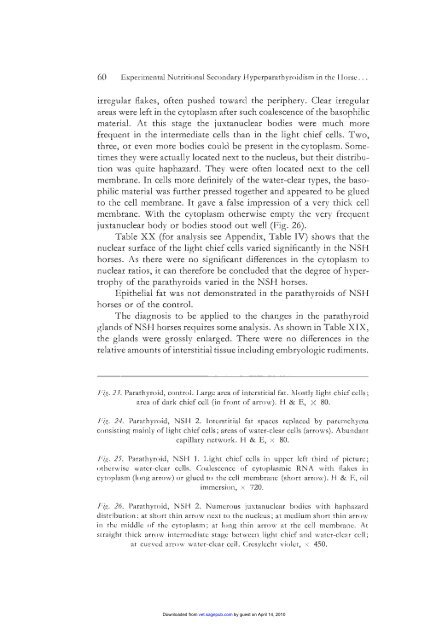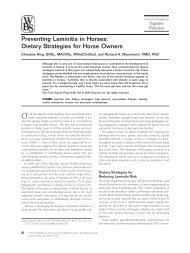Nutritional Secondary Hyperparathyroidism in the Horse
Nutritional Secondary Hyperparathyroidism in the Horse
Nutritional Secondary Hyperparathyroidism in the Horse
Create successful ePaper yourself
Turn your PDF publications into a flip-book with our unique Google optimized e-Paper software.
(10 Lxpcrimental <strong>Nutritional</strong> Sccondary ~lypcrparathyroidism <strong>in</strong> <strong>the</strong> I lorse , . .<br />
irregular flakes, often pushed toward <strong>the</strong> periphery. Clear irregular<br />
areas were left <strong>in</strong> <strong>the</strong> cytoplasm after such coalescence of <strong>the</strong> basophilic<br />
material. At this stage <strong>the</strong> juxtanuclear bodies were much more<br />
frequent <strong>in</strong> <strong>the</strong> <strong>in</strong>termediate cells than <strong>in</strong> <strong>the</strong> light chief cells. Two,<br />
three, or even more bodies could be present <strong>in</strong> <strong>the</strong> cytoplasm. Some-<br />
times <strong>the</strong>y were actually located next to <strong>the</strong> nucleus, but <strong>the</strong>ir distribu-<br />
tion was quite haphazard. They were often located next to <strong>the</strong> cell<br />
membrane. In cells more def<strong>in</strong>itely of <strong>the</strong> water-clear types, <strong>the</strong> baso-<br />
philic material was fur<strong>the</strong>r pressed toge<strong>the</strong>r and appeared to be glued<br />
to <strong>the</strong> cell membrane. It gave a false impression of a very thick cell<br />
membrane. With <strong>the</strong> cytoplasm o<strong>the</strong>rwise empty <strong>the</strong> very frequent<br />
juxtanuclear body or bodies stood out well (Fig. 26).<br />
Table XX (for analysis see Appendix, Table IV) shows that <strong>the</strong><br />
nuclear surface of <strong>the</strong> light chief cells varied significantly <strong>in</strong> <strong>the</strong> NStl<br />
horses. As <strong>the</strong>re were no significant differences <strong>in</strong> <strong>the</strong> cytoplasm to<br />
nuclear ratios, it can <strong>the</strong>refore be concluded that <strong>the</strong> degree of hyper-<br />
trophy of <strong>the</strong> parathyroids varied <strong>in</strong> <strong>the</strong> NSH horses.<br />
Epi<strong>the</strong>lial fat was not demonstrated <strong>in</strong> <strong>the</strong> parathyroids of NSH<br />
horses or of <strong>the</strong> control.<br />
The diagnosis to be applied to <strong>the</strong> changes <strong>in</strong> <strong>the</strong> parathyroid<br />
glands of NSH horses requires some analysis. As shown <strong>in</strong> Table XIX,<br />
<strong>the</strong> glands were grossly enlarged. There were no differences <strong>in</strong> <strong>the</strong><br />
relative amounts of <strong>in</strong>terstitial tissue <strong>in</strong>clud<strong>in</strong>g embryologic rudiments.<br />
/,/,q. 27. I’arathyroid, coiitrol. Jmgc area of <strong>in</strong>terstitial fat. hlostly light chief cells;<br />
area of dark chief cell (<strong>in</strong> front of arrovrr). El & E, x 80.<br />
/;(’. 24. I’arathyroid, NSIH 2. Interstitial fat spaces rcplaccd by parcmcliynia<br />
consist<strong>in</strong>g ma<strong>in</strong>ly of light chief cells ; areas of watcr-clcar cells (arrows). Abund;uit<br />
capillary network. 1-1 h E, x 80.<br />
1;i.r. 25. l’arathyroid, NSIH 1. I.ight chief cells <strong>in</strong> upper left third of picture;<br />
o<strong>the</strong>rwise water-clear cells. Coalcsccncc of cytoplasmic RNA with flakes <strong>in</strong><br />
cytoplasm (long arrow) or glued to <strong>the</strong> cell mcmhranc (short arrolv). 1-1 & E, oil<br />
itnmcrsion, Y 720.<br />
f(q. 26. I’arathyroid, NSI-1 2. Nurncrous justanuclcar bodies \\.it11 haphazard<br />
distribution: at short th<strong>in</strong> arrow nest to <strong>the</strong> nucleus; at <strong>in</strong>cdiuni short th<strong>in</strong> arro\\.<br />
<strong>in</strong> <strong>the</strong> middle of <strong>the</strong> cytoplasm; at long th<strong>in</strong> arro\y at thc cell membrane. At<br />
straighi thick arrow <strong>in</strong>tcrmcdiatc stage Ixtwccn light chief acid \i,:itcr-clc:ii- cell :<br />
at curved arro\r water-clear ccll. Crcsylccht violet, x 450.<br />
Downloaded from<br />
vet.sagepub.com by guest on April 14, 2010



